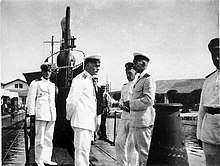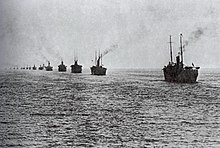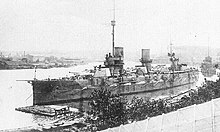Russian squadron
As the Russian Squadron ( Russian Русская Эскадра ; also: Wrangel's Fleet , White Fleet or Fleet of the White Army ), the remainder of the Imperial Russian Black Sea Fleet , which stood on the side of the White Army of General Pyotr Nikolayevich Wrangel in the Russian Civil War and thereafter up to Was interned in French Tunisia in 1924 .
history
Lenin had ordered the self-sinking of the fleet on June 18, 1918 so that the ships would not fall into the hands of the counter-revolution or foreign intervention troops during the civil war, but part of the Black Sea fleet was still transferred to the White Army. These ships were stationed in Sevastopol and other ports on the Black Sea and supported the fight of the White Army against the Bolsheviks in the Black Sea region. When the Red Army conquered the Crimean peninsula in November 1920 , the fleet evacuated troops, their families and civilians from Sevastopol, Yalta , Feodosia , Evpatoria and Kerch from November 10th . The total number of voluntary exiles was around 150,000.
On November 14th, the remaining ships were moved to Constantinople . There they were reorganized on November 21 in the so-called Russian Squadron , consisting of four divisions, under the command of Rear Admiral Mikhail Kedrov (1878-1945). After the French Council of Ministers approved the transfer of the squadron to Bizerta in what was then the French protectorate of Tunisia on December 1, 1920 , the fleet moved there from December 1920 to February 1921. The first ships left Constantinople on December 12th, reached Bizerta on December 19th, 1920 and were interned there. Around 4,500 civilian refugees , mostly members of the ship's crews , came with the fleet to Bizerta. From January 1921, when Admiral Kedrow was transferred to Paris, the fleet in Bizerta was under the command of Rear Admiral Michail Berens (1879-1943).

When France recognized the Soviet Union under international law in 1924 , it formally handed the ships over to the Soviet Union on October 29, 1924. A Soviet naval delegation led by Alexei Krylov traveled to Bizerta in December, but found the ships no longer usable. In the meantime, not only were some of them very outdated, but also in poor condition due to a lack of funds, spare parts and maintenance. They were therefore sold and gradually scrapped. Some of the ships were used in the French, Italian and Maltese merchant navies . Most of the crews remained in Tunisia or France as emigrants.
The ships of the squadron
The remaining fleet consisted of a modern Dreadnought - Battleship , an outdated pre-dreadnought battleship , a protected cruiser , one light cruiser , ten destroyers and torpedo boats , four submarines , three gunboats , one Aviso , two minesweepers , three armed and unarmed icebreakers , a guard boat, two hydrography ships, two training ships , a rescue ship , three tugs , a workshop ship , a submarine tender , an (unfinished) water tanker , a steamer, and 19 transport ships.
- Ships of the line:
- General Alexejew ("Генерал Алексеев", ex Volja )
- Georgi Pobedonossets ("Георгий Победоносец")
- Protected cruiser:
- General Kornilov ("Генерал Корнилов", ex Kagul , ex Otschakov )
- Small cruiser:
- Almas ("Алмаз")
- Destroyers / torpedo boats:
- Captain Saken ("Капитан Сакен")
- Bespokoiny ("Беспокойный")
- Dersky («Дерзкий»)
- Gnewny («Гневный»)
- Pospeschny ("Поспешный")
- Pylki («Пылкий»)
- Zerigo ("Цериго")
- Sharki («Жarki»)
- Swonki («Звонкий»)
- Sorki («Зоркий»)
- Submarines:
- Tjulen ("Тюлень")
- Burewestnik ("Буревестник")
- AG-22 ("АГ-22")
- Utka ("Утка")
- Gunboats:
- Strasch («Страж»)
- Grozny («Грозный»)
- Yakut («Якут»)
- Advice:
- Kitoboi ("Китобой")
- Minesweepers:
- Albatross ("Альбатрос")
- Baklan («Баклан»)
- Armed icebreakers:
- Vzadnik ("Всадник"; ex icebreaker No. 1, "Ледокол № 1")
- Gaidamak ("Гайдамак"; ex Eisbrecher No. 2, "Ледокол № 2")
- Djigit ("Jigit"; ex icebreaker No. 3, "Ледокол № 3")
- Icebreaker:
- Ilya Muromets ("Илья Муромец")
- Hydrographic ships:
- Wecha («Веха»)
- Kazbek ( "Казбек»)
- Training ship:
- Morjak ("Моряк")
- Svoboda ("Свобода")
- Recovery ship:
- Chernomor ("Черномор")
- Tractor:
- Holland («Голланд»)
- Welbek («Бельбек»)
- Sevastopol ("Севастополь")
- Workshop ship:
- Kronstadt («Кронштадт»)
- Submarine tender:
- Dobycha ("Добыча")
- Tanker (unfinished):
- Baku («Баку»)
- Steam boat:
- Grand Duke Constantine ("Великий князь Константин")
- Transporter:
- Don ("Дон")
- Crimea («Крым»)
- Dalland ("Далланд")
- Shchilka ("Шилка")
- Samara ("Самара")
- Ekaterinodar ("Екатеринодар")
- Rion («Рион»)
- Inkerman ("Инкерман")
- Poti («Поти»)
- Yalta («Ялта»)
- Buzzard ( "Сарыч»)
- Ostoroschny ("Осторожный")
- Turkestan ("Туркестан")
- Olga ( Sukhum ) ("Ольга" ("Сухум"))
- Zarya «Заря»
- Psesuape "Псезуапе"
- Elpidifor № 410 Wera («Вера»)
- Elpidifor № 412
- Elpidifor № 413
annotation
Only 32 naves are mentioned on the marble slab in the Russian Orthodox Alexander Nevsky Church, built in 1935 by the Russian community in exile in Bizerta . Are not listed there: AG-22 ( "АГ-22"), Albatros ( "Альбатрос") Baklan ( "Баклан") Wecha ( "Веха"), Kazbek ( "Казбек") Welbek ( "Бельбек») , Sevastopol ("Севастополь"), Kronstadt ("Кронштадт") and the 19 transport ships.
Individual evidence
- ^ New York Times , December 14, 1920: Wrangel's Fleet Sails .
- ↑ Sometimes referred to as Aviso
- ↑ Sometimes also called minesweeper or connection boat
- ↑ Sometimes referred to as gunboats
- ↑ From 1923 in French Pollux
- ↑ Sometimes referred to as a tractor
- ↑ http://www.voskres.ru/army/spirit/bizerta.htm
Web links
literature
- BE Колупаев: Русский флот в Африке. Военно-исторический архив. Moscow, 2002.
- M. Панова: Русский Тунис - Русская мысль. Paris, 1998.
- AA Ширинская: Бизерта. Последняя стоянка. Отечество, 2003.
- Г. Л. Языков: Эвакуация Черноморского флота из Крыма в Бизерту в 1920 году. Новый часовой, 1996 (pp. 160–166).













